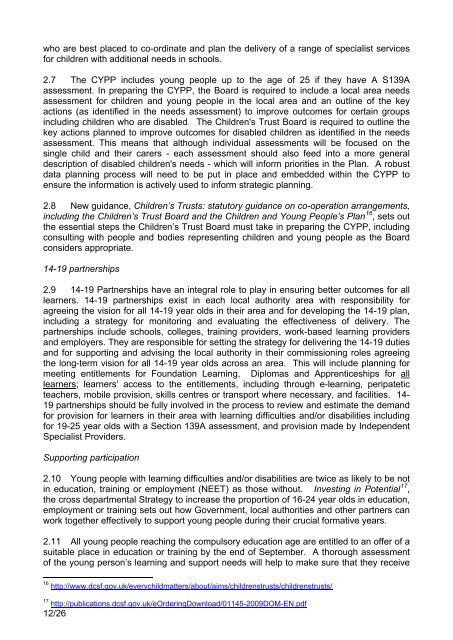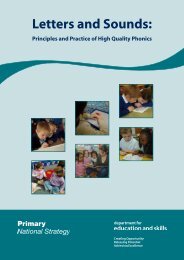Supporting young people with learning difficulties to participate and ...
Supporting young people with learning difficulties to participate and ...
Supporting young people with learning difficulties to participate and ...
You also want an ePaper? Increase the reach of your titles
YUMPU automatically turns print PDFs into web optimized ePapers that Google loves.
who are best placed <strong>to</strong> co-ordinate <strong>and</strong> plan the delivery of a range of specialist services<br />
for children <strong>with</strong> additional needs in schools.<br />
2.7 The CYPP includes <strong>young</strong> <strong>people</strong> up <strong>to</strong> the age of 25 if they have A S139A<br />
assessment. In preparing the CYPP, the Board is required <strong>to</strong> include a local area needs<br />
assessment for children <strong>and</strong> <strong>young</strong> <strong>people</strong> in the local area <strong>and</strong> an outline of the key<br />
actions (as identified in the needs assessment) <strong>to</strong> improve outcomes for certain groups<br />
including children who are disabled. The Children's Trust Board is required <strong>to</strong> outline the<br />
key actions planned <strong>to</strong> improve outcomes for disabled children as identified in the needs<br />
assessment. This means that although individual assessments will be focused on the<br />
single child <strong>and</strong> their carers - each assessment should also feed in<strong>to</strong> a more general<br />
description of disabled children's needs - which will inform priorities in the Plan. A robust<br />
data planning process will need <strong>to</strong> be put in place <strong>and</strong> embedded <strong>with</strong>in the CYPP <strong>to</strong><br />
ensure the information is actively used <strong>to</strong> inform strategic planning.<br />
2.8 New guidance, Children’s Trusts: statu<strong>to</strong>ry guidance on co-operation arrangements,<br />
including the Children’s Trust Board <strong>and</strong> the Children <strong>and</strong> Young People’s Plan 16 , sets out<br />
the essential steps the Children’s Trust Board must take in preparing the CYPP, including<br />
consulting <strong>with</strong> <strong>people</strong> <strong>and</strong> bodies representing children <strong>and</strong> <strong>young</strong> <strong>people</strong> as the Board<br />
considers appropriate.<br />
14-19 partnerships<br />
2.9 14-19 Partnerships have an integral role <strong>to</strong> play in ensuring better outcomes for all<br />
learners. 14-19 partnerships exist in each local authority area <strong>with</strong> responsibility for<br />
agreeing the vision for all 14-19 year olds in their area <strong>and</strong> for developing the 14-19 plan,<br />
including a strategy for moni<strong>to</strong>ring <strong>and</strong> evaluating the effectiveness of delivery. The<br />
partnerships include schools, colleges, training providers, work-based <strong>learning</strong> providers<br />
<strong>and</strong> employers. They are responsible for setting the strategy for delivering the 14-19 duties<br />
<strong>and</strong> for supporting <strong>and</strong> advising the local authority in their commissioning roles agreeing<br />
the long-term vision for all 14-19 year olds across an area. This will include planning for<br />
meeting entitlements for Foundation Learning, Diplomas <strong>and</strong> Apprenticeships for all<br />
learners; learners’ access <strong>to</strong> the entitlements, including through e-<strong>learning</strong>, peripatetic<br />
teachers, mobile provision, skills centres or transport where necessary, <strong>and</strong> facilities. 14-<br />
19 partnerships should be fully involved in the process <strong>to</strong> review <strong>and</strong> estimate the dem<strong>and</strong><br />
for provision for learners in their area <strong>with</strong> <strong>learning</strong> <strong>difficulties</strong> <strong>and</strong>/or disabilities including<br />
for 19-25 year olds <strong>with</strong> a Section 139A assessment, <strong>and</strong> provision made by Independent<br />
Specialist Providers.<br />
<strong>Supporting</strong> participation<br />
2.10 Young <strong>people</strong> <strong>with</strong> <strong>learning</strong> <strong>difficulties</strong> <strong>and</strong>/or disabilities are twice as likely <strong>to</strong> be not<br />
17<br />
in education, training or employment (NEET) as those <strong>with</strong>out. Investing in Potential ,<br />
the cross departmental Strategy <strong>to</strong> increase the proportion of 16-24 year olds in education,<br />
employment or training sets out how Government, local authorities <strong>and</strong> other partners can<br />
work <strong>to</strong>gether effectively <strong>to</strong> support <strong>young</strong> <strong>people</strong> during their crucial formative years.<br />
2.11 All <strong>young</strong> <strong>people</strong> reaching the compulsory education age are entitled <strong>to</strong> an offer of a<br />
suitable place in education or training by the end of September. A thorough assessment<br />
of the <strong>young</strong> person’s <strong>learning</strong> <strong>and</strong> support needs will help <strong>to</strong> make sure that they receive<br />
16 http://www.dcsf.gov.uk/everychildmatters/about/aims/childrenstrusts/childrenstrusts/<br />
17 http://publications.dcsf.gov.uk/eOrderingDownload/01145-2009DOM-EN.pdf<br />
12/26
















